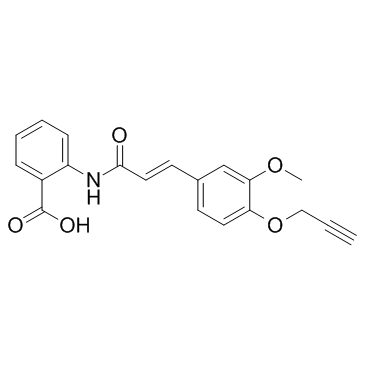| Cas No.: | 1001288-58-9 |
| Chemical Name: | Benzoic acid, 2-[[(2E)-3-[3-methoxy-4-(2-propyn-1-yloxy)phenyl]-1-oxo-2-propen-1-yl]amino]- |
| Synonyms: | FT011;SHP-627;FT-011;FT 011 |
| SMILES: | COC1=C(C=CC(=C1)/C=C/C(=O)NC2=CC=CC=C2C(=O)O)OCC#C |
| Formula: | C20H17NO5 |
| M.Wt: | 351.3527 |
| Purity: | >98% |
| Sotrage: | 2 years -20°C Powder, 2 weeks 4°C in DMSO, 6 months -80°C in DMSO |
| Description: | FT011, a new anti-fibrotic and an anti-inflammatory agent, prevents glycogen accumulation by reducing glycogenin mRNA translation. |
| In Vivo: | The reference for FT011 is 200 mg/kg/day [1]. rats are studied for 8 and 32 weeks and receiving intravitreal injections of FT011 (50 μM). FT011 reduces etinal leukostasis, microglial density and mRNA levels of intercellular adhesion molecule-1 (ICAM-1). Late intervention with FT011 reducesacellular capillaries and the elevated mRNA levels of collagen IV and fibronectin in diabetic rats. [2] |
| In Vitro: | FT011 do not change glycogen synthase or glycogen phosphorylase enzyme activities but prevent both glycogenin mRNA synthesis and accumulation of Armanni-Ebstein lesions in the diabetic kidney. [1] FT011 inhibit both TGF-β1 and PDGF-BB induced collagen production as well as PDGF-BB-mediated mesangial proliferation. FT011 reduced albuminuria, glomerulosclerosis and tubulointerstitial fibrosis. [3] |
| References: | [1]. Lau X Attenuation of Armanni-Ebstein lesions in a rat model of diabetes by a new anti-fibrotic, anti-inflammatory agent, FT011. Diabetologia. 2013 Mar;56(3):675-9. [2]. Deliyanti D et al. FT011, a Novel Cardiorenal Protective Drug, Reduces Inflammation, Gliosis and Vascular Injury in Rats with Diabetic Retinopathy. PLoS One. 2015 Jul 29;10(7):e0134392. [3]. Gilbert RE et al. A purpose-synthesised anti-fibrotic agent attenuates experimental kidney diseases in the rat. PLoS One. 2012;7(10) |

 To enhance service speed and avoid tariff delays, we've opened a US warehouse. All US orders ship directly from our US facility.
To enhance service speed and avoid tariff delays, we've opened a US warehouse. All US orders ship directly from our US facility.




















